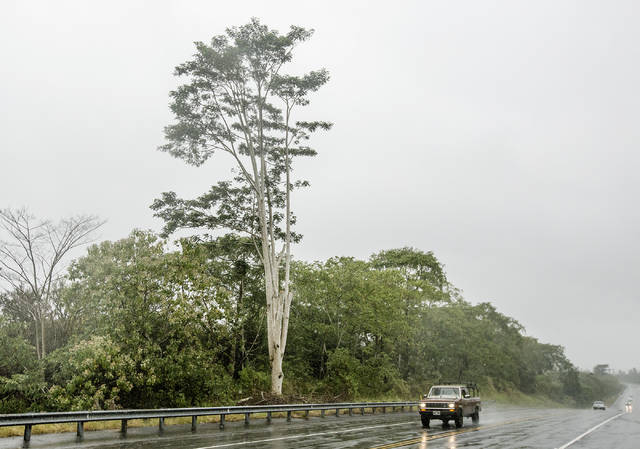The Hawaii Island Albizia Task Force announced it will carry out a series of albizia control projects costing $1 million within the next several weeks on the east side of the Big Island.
The task force — which includes representatives from the Big Island Invasive Species Committee, state Department of Transportation, Hawaii County Civil Defense, Hawaii Electric Light Co., U.S. Forest Service and other organizations — has four projects planned for East Hawaii.
Springer Kaye, manager at the Big Island Invasive Species Committee, said the first project is nearly complete. That project, which will cost more than $200,000, involves clearing all albizia within 100 meters of a 1-mile stretch of the Puainako Extension, where 17-year-old trees reaching more than 100 feet tall have caused significant traffic hazards.
The task force also has plans to clear albizia overhanging Hoolaulima Road near the Hilo landfill, as well as within a 2-mile stretch of Kekuanaoa Street where it accesses Hilo International Airport.
Finally, a 200-foot-tall albizia on Halai Street, which poses a significant danger to surrounding residences, will be removed.
The three upcoming projects will begin as arborists are available, Kaye said, and is expected take about four weeks to complete.
Kaye said arborists will trim back trees located closer to roads and other structures before treating their remains with herbicides to prevent the dying trees from collapsing onto roads or power lines. Trees farther away from structures will be treated with herbicides without needing to be cut down.
Additional albizia abatement projects, including clearing operations at Makuu Drive in Keaau and Kapoho Road in Pahoa, are planned to be completed this year as well, according to a 2017 impact report from the Big Island Invasive Species Committee. The report also said projects are scheduled for Kahakai Boulevard in Pahoa and Waianuenue Avenue in Hilo in 2019.
Kaye was gratified that residents are beginning to understand the hazards of the fast-growing trees.
“It’s taken awhile, but people really get now that these are invasive trees and we don’t want them, we want better trees,” Kaye said.
Albizia’s tendency to shed large branches in heavy rain poses a significant danger to nearby structures, people and roadways. After Tropical Storm Iselle struck the island in 2014, albizia limbs blocked roads throughout Puna and disabled power lines for days.
In addition, because albizia fixes nitrogen in the soil, the trees create a welcome environment for other invasive species which crowd out local plants that have evolved to thrive in Hawaii’s nitrogen-poor soil. The excess nitrogen also can accumulate in river gulches and contaminate runoff water.
“Our primary concern is safety,” said Bill Buckley, BIISC albizia project coordinator in a statement. “These are some of the most heavily used streets in East Hawaii, and falling trees and branches severely impact access and can potentially cause serious injury.”
Email Michael Brestovansky at mbrestovansky@hawaiitribune-herald.com.





Can we eradicate the car thieves first?
It’s more than high time that laws/ordinances be passed requiring absentee property owners be required to maintain their properties which pose dangers and damages to abutting/adjoining residences. It’s absolute nonsense that the owners of said residences have to go through a process (Civil Defense) time and again to get these (mostly) mainland owners to address this proble,. What is needed is collaboration between state and county government (elected council persons) to achieve this end. For them to turn a blind eye and expect residential owners to ‘take action’ by insinuating that “hey, you can go ahead and do the work yourself” is cheap and dismissive and derelict of their responsibilities. I’ve been at this end since the mid-1990’s, and all that occurred was the state saying it’s the counties kuleana and the county passing the hot potato back to the state…..this is representative government?
I think they passed a law a few years back, you can sue for damages from and/or costs costs incurred in removing hazard trees
Years back I checked w/lawyer(s)…..If the owner is in the mainland (or out of state) you have to have them served within said state or wherever….all in all, if even served, they are not compelled to arrive in Hawaii so it makes for an expensive process…..unless it’s major league damage, I’m not certain even your insurance company will go after them (?)
Only in Hawaii would a natural resource like Albizia be relegated to a weed status that requires vast amounts of money to throw away valuable fiber and wood. If we brought the government of China in to help, a viable industry could be created for a steady supply of high quality raw materials. We are too ignorant and backwards to capitalize on this opportunity to create wood and fiber industry around an inexpensive (valuable) resource. Ditto for the Eucalyptus groves planted on the burned out sugar cane land. Once again rationalization is confused with logic here in the land of missed opportunity.
The Eucalyptus trees on all that Kamehameha School land on the Hamakua coast was supposed to be sold to China for paper. China backed out and now we have an ugly scenic drive that once was beautiful. Albizia out compete for resources of native plants in places like Akaka Falls.
Way to go BIISC and all the rest! Nice to see the county really starting to use the unsafe flora ordinance and new authority granted by the state last year to take down hazardous trees when the owner won’t. I’ve heard the cut wood is completely up for grabs–if you can use it, just stop by and ask for it–if you have a truck big enough to haul away that wet heavy wood of course! Otherwise, back to soil it goes!